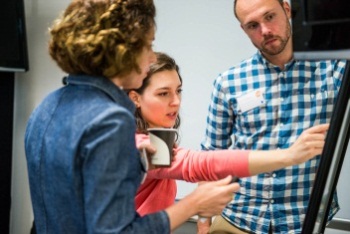Nest Insight is here to find solutions. We’ve been set up to help ensure that the new mass-market of pension savers get the best possible outcomes when they retire. This means finding new ways of reaching millions of people who don’t always have a lot of help or expertise when it comes to retirement savings.
Nest Insight has the support of some of the world’s leading experts on financial behaviour – and we’re learning the lessons of innovative research from around the world. But even the most robust theoretical ideas mean nothing until they’re rigorously tested in the real world, with real people. This is why Nest Insight is taking a highly practical approach to solving problems and testing solutions.
Over the past few years, the technology sector has led the way in user-centred design. The apps we know and love from our smartphones didn’t get to be so seamless and intuitive by accident. They’re the products of a highly evidence-based design approach that places at its heart the people who actually use these tools – us. The pensions sector has much to learn from these techniques. Digital channels will play a vital role in reaching the huge and diverse new population of DC pension savers. This is why, with the help of our technology partner, TCS, we chose to run an appathon as part of our first Nest Insight event, in June 2016. We brought together teams of digital designers and developers from a range of organisations and gave them just 36 hours to solve an age-old challenge: how to encourage people to put aside more money for the long term. They did this by designing prototype apps.
We didn’t know exactly what to expect, especially given the very tight timetable – and we realised that one more app would not on its own be the solution to this generational challenge. Nonetheless, the results were genuinely exciting. We’re now looking at ways to develop some of the teams’ best concepts and test them with real-life DC savers. We’ll update you on this work as it progresses. For now, here’s the story of how we staged a pensions appathon.
We delivered the 2016 Appathon in partnership with TATA Consultancy Services, with additional support from the Open University.
Problem statement
Every digital design process starts with a problem statement. Our appathon needed a clear and specific articulation of the problem, to make sure all the teams were working on the same challenge. Also, because we were taking a user-centred approach, this problem statement needed to include a clear articulation of the user need.
All too often, digital tools are designed to suit the technology or process that an organisation wishes people to use; rather than to meet the needs of the people who will use them. A particular challenge in defining the user need for our appathon was the fact that long-term saving is a latent need. It’s a need people don’t always realise they have. Saving for the future is something people often don’t realise they need to do until it’s too late. This is why our problem statement didn’t simply state the end goal of the appathon – encouraging people to save at an adequate level. It also set out the barriers: people’s low levels of engagement and understanding.
The full problem statement was:
Background
Millions of people have been auto-enrolled into a DC pension. This means they have to make their own choices about how much to save. Most of them have a gap in their savings rate. But they’re mostly unengaged and not motivated to take action.
Challenge
Create an app/tool that gamifies long-term savings and motivates the user to save at an adequate rate. The app will need to present data on current and future account values, and retirement outcomes, in a way that users can understand. It should create soft, short-term rewards to motivate the user to save enough. This could be done step-by-step or in one go.
Considerations
Your solution will need to take into account:
- people’s low level of understanding
- the balance between present and future priorities
- behavioural biases and psychological barriers
- risk aversion.
Data
Appathons also require a broad range of relevant data, so participants can create relevant and realistic solutions. Because we were taking a user-centred approach, we started with a solid base of evidence about the users we were looking to help. In this case, this meant the ‘DC generation’ – people whose non-State retirement income will depend on defined contribution pensions. The teams were provided with a wealth of relevant source data, including profiles of a range of typical DC savers, dummy pension account data for these individuals, and projected returns from their investments.
The appathon began with an intensive session where we explored these data, and reviewed existing evidence on the barriers facing pension savers. In particular, we focused on the wide range of behavioural biases that stand in the way of long-term savings. These were summed up in the following graphic:

The teams would need to overcome these biases by the imaginative use of behavioural nudges.
After a series of exercises and activities designed to focus the participants on the needs of their end users, the teams began to develop their app ideas.
The masterclass
One of the presenters at the Nest Insight conference was our Senior Academic Advisor, Professor Shlomo Benartzi. Shlomo is one of the world’s leading authorities on behavioural finance. His recent book, The Smarter Screen, is already a go-to text on the role of digital platforms in driving financial behaviour. Having him in the building during our appathon was too good an opportunity to pass up. So during the afternoon of the first day, the appathon teams were invited into the main conference hall to pitch their concepts to Shlomo in a ‘behavioural masterclass’.
It takes a great deal of courage to expose a fledgling idea to a hall full of industry professionals, academics and policy people – but this is exactly what the teams did. This opening up of the creative process was an essential part of the appathon. We wanted delegates to experience first-hand the rapid and productive atmosphere of the user-centred design process. This is a technique we believe could be applied much more widely in the sector.
Using mobile phone photos of their whiteboard sketches, each team talked conference delegates through their concepts – and in particular the behavioural nudges they had chosen to use in their apps. These included innovative and often playful ways of:
- visualising the future
- making use of ‘found money’ that people can save without missing it
- creating ‘soft’ on-screen rewards to reinforce savings behaviour.
In response, Shlomo gave feedback on the most positive ideas, and also on potential pitfalls to avoid. He cited a wealth of past behavioural evidence for the teams to consider. The teams then returned to the appathon room and revised their ideas in the light of the feedback. They then spent the remaining time hacking the data and putting together working prototypes of their concepts for the judges to review.
Judging took place after the end of the main conference. Conference delegates were invited to attend a ‘show and tell’ of the teams’ work, and to vote on their preferred concept. A team of judges chaired by Nest’s CEO, Helen Dean then made its final assessment.
The winning entry: SaveApp
All the teams had produced original and distinct concepts to meet the challenge – but in the end the Nest judges and the conference delegates agreed that there was a clear winner. This was the SaveApp, developed by a team from Aviva Digital and Razorfish.

Team members Vivien Collignon, Malwina Stepien and Elvia Vasconsoles had looked for ways to encourage younger savers to increase their savings rates. They focused on users from the hard-to-reach millennial generation. These idea boards, developed during the appathon, reveal their thinking.


Based on an intensive design process, and feedback from the behavioural masterclass, the team concentrated on two principles:
- automatic saving – making savings ‘invisible’
- gamification – making savings habit-forming.
They brought these principles to life through features they called life goals, tips and missions:

Life goals are created when the user gets started – these might include ‘house’, ‘rainy day’ or ‘car’. These pots give to the user motivation by seeing her final goals. They appear in the app as living creatures. Like Pokémons or Tamagotchis, these creatures get sick if the user isn’t saving enough. They also get bigger and happier if the user saves regularly. A pension life-goal is added by default to the shorter-term goals set by the user.
Tips prompt the user to change their behaviour in small, iterative ways. SaveApp studies users’ spending habits using banking data, then suggests new saving opportunities. The money saved by following a tip is automatically allocated to savings. This helps the user get in the savings habit.
Missions are automatic saving suggestions the user can choose and customize. For example she can decide to save £0.50 each time she buys a coffee.
To see how this works in practice, the team created a video of their prototype in action:
Save up – Nest Appathon winning entry from elvia vasconcelos on Vimeo.
The judges’ verdict
In announcing the winner, Helen Dean listed three features that sealed victory for the SaveApp:
- a very clear focus on the target user and their barriers to saving
- a joined-up approach that placed long-terms savings as part of a ‘family’ of savings goals that also included short and medium term objectives
- a clever use of the ‘found money’ concept – helping users save in ways that would feel invisible to them.
What next?
From the outset, Nest Insight and TCS were clear that we didn’t want the appathon to be a ‘flash in the pan’. All too often appathons generate rich and valuable concepts that are never taken forward and turned into live applications. This is why we involved the Open University from the outset.
We are working with the OU to develop field trials that will test the effectiveness of different forms of intervention on savings behaviour. The aim now is to take the best of all the concepts developed in the hackathon and take them forward for to testing with real-life DC savers.
We’ll be using this blog to keep you posted on this work as it develops.







